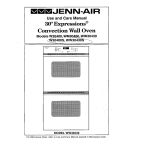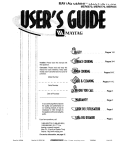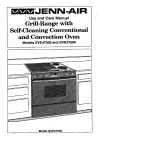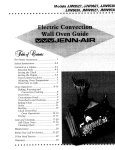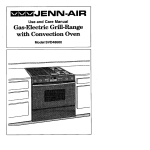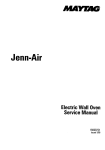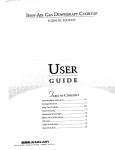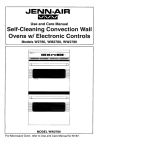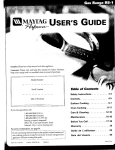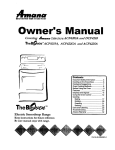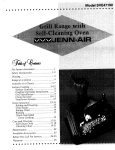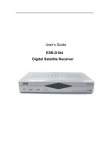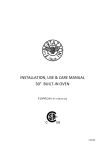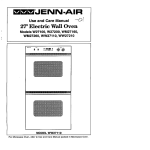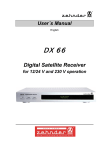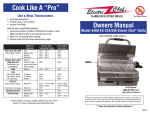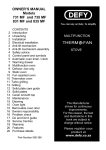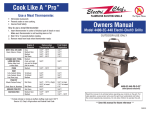Download Cub Cadet GTX1054 Lawn Mower User Manual
Transcript
EEEJENN-AIR
Use and Care Manual
27" Expressions ®
Convection Wall Oven
Models W27400, WM27460, WW27430
_7400S,
_;.-.:..
WW27430S
.:_;:.. ::_y+.';!;_
=========================
:::::::::::::::::::::::::
:::::_¢;
MODEL WW27430
For Microwave Oven, refer to Else and Care M_nual pscked in Microwave Oven.
7
Congratulationson your choice of a Jenn-Air wall oven. Your Jenn-Air convection oven
combinesthe best of four cooking methods:conventionalbakingor roasting,convection
baking, convection roasting, and broiling, in a self-cleaning oven.
The Jenn-Air convection oven is actually a conventionaloven that circulates heated air
within the oven. As both bake and broil heating elements cycle on and off with the
thermostat, a fan keeps the heated air circulating around the food. The constantly
recirculating heated air in the convection oven strips away the layer of cooler air that
surroundsfood. Consequently,many foods cook more quickly. Distributedheat makes
multiple rack cooking possible. Convectionroasted meats retaintheir natural flavor and
juiciness with less shrinkage than conventional roasting.
Before you begin cooking with your new oven, please take a few minutes to read and
become familiar with the instructions in this book. On the following pages you will find
a wealth of informationregarding all aspects of using your new oven. By following the
instructionscarefully,you will be able to fully enjoy and properly maintainyour oven and
achieve excellent results with the food you prepare.
Should you have any questions about using your Jenn-Air oven, write to us. Be sure
to provide the model number.
JennoAirCustomer Assistance
c/o MaytagCustomerService
P.O. Box 2370
Cleveland,TN 37320-2370
Model Number
Serial Number
(numbers appear on the serial plate on the oven front frame)
Date Purchased
JENN-AIR DEALER FROM WHOM PURCHASED
Address
City
Phone
Baking
........ 15
Bak'g
n Chart ................................
.................................
16
Causes of Cake Failure .............. ..............................................
15-17
Convect Baking ................
.......................................................
.. 17
Convect Cooking on Multiple RacKs .......................................................... 14
General Recommendations ...............................................................
................. 35-36
Before You Call For Service ..........................
Broiling
.......... 26
Broiling ............................................................................................
27
Bro ng Tips ........................................................................................
27
Broiling Chart ...............................................................................................
Caring for Your Oven
...............................................................
Adjust Oven Temperature ......
Ch d Protection Lock •....................
........................................
C ean ng Other Surfaces ...... i ....
.......................................
Oven Light Bulb Rep acemen .............................................
34
34
32
.... 33
Cleaning
Self-Cleaning Process28-32
Clock Controls
12-13
Clock Controlled Baking or Roasting ......................................................
10
T me of Day Clock ........................................................................................ 11
Timer ...........................................................................................................
Oven Operation
6
...........................................
Oven Control Panel ......................
9
Rack Positions ..............
......................................................
.8
Setting Controls ........................................................................
...... 22-25
Probe ....................................................................
Roasting
Conventional Roasting Recommendations18
Convect Roasting ................................................................................... 19-2121
Frozen Convenience Foods ........................................................................ 18
Genera Roasting Recommendations .......................................................... 19
P,oasting Chart ..........................................................................................
Safety Precautions .....................................................................
4-5
Read before operating your oven
All appliances - regardless of the manufacturer - have the potential through
improper or careless use to create safety problems. Therefore the following
safety precautions should be observed:
1.
2.
3.
4.
5.
6.
7.
8.
9.
10.
11.
12.
13.
14.
15.
16.
Be sure your appliance is properly installed and grounded by a qualified
technician.
Never use your appliance for warming or heating the room.
Childrenshould not be left alone or unattendedin area where appliance
is in use. They should neverbe allowed to sit or stand on any part of the
appliance.
Wear proper apparel. Loose-fittingor hanginggarmentsshould neverbe
worn while using the appliance.
Do not repair or replace any part of the appliance unless specifically
recommendedinthis manual. Allother servicingshould be referredto an
authorizedJenn-Air Service Contractor.
Flammablematerialsshould not be stored in an oven.
Do not use water on grease fires. Smother fire or flame or use dry
chemical or foam-type extinguisher.
Use only dry pothelders. Moist or damppotholdereon hot surfaces may
result in burns from steam. Do not let potholder touch hot heating
elements. Do not use a towel or other bulky cloth.
Use care when openingoven door. Let hot air or steam escape before
removingor replacing food.
Do not heat unopenedfood containers. Build-up of pressure may cause
container to burst and result in injury.
Keep oven vent ducts unobstructed.
Always placeovenracks indesired locationwhile oveniscool. Ifrack must
be moved while oven is hot, do not let potholder contact hot heating
element in oven.
Do not clean door gasket. The door gasket is essential for a good seal.
Care should be taken not to rub, damage, or move the gasket.
Do not use oven cleaners. No commercialoven cleaner or oven liner
protectivecoating of anykind should be used in or aroundany part of the
oven.
Clean only parts listed in this manual.
CAUTION: BEFORESELF-CLEANINGTHE OVEN, REMOVE FOOD,
BROILER PAN AND OTHER UTENSILS.
17.
18.
'
19.
20.
21.
Listenfor fan. A fan noiseshouldbe heardduring the bake,convectbake,
convect roast,broil and cleaning cycles, If not, call a serviceman.
DONOTTOUCH HEATINGELEMENTSORINTERIORSURFACESOF
OVEN. Heatingelementsmay be hot even though they are dark in color.
Interiorsurfaces of anyoven become hot enoughto cause burns. During
and after use, do not touch, or let clothing or other flammable materials
contact heating elementsor interior surfaces of oven untilthey have had
sufficienttime to cool. Other surfaces of the appliance may become hot
enough to cause burns-amongthese surfaces are: oven vent openings
and surfaces nearthese openings,oven doors, windows of oven doors.
PREPAREDFOOD WARNING:Followfood manufacturer'sinstructions.
If a plastic frozen food containerand/or its film cover distorts,warps or is
otherwisedamaged during cooking,immediatelydiscardthe food and its
container. The food could be contaminated.
This appliance has beentested for safe performanceusing conventional
ceokware. Do not useanydevices or accessoriesthat are not specifically
recommended in this manual. De not use add-on convection systems.
The use of devices or accessoriesthat are not expressly recommended
in this manualcould create serioussafety hazards, resultin performance
problems, and reduce the life of the componentsof the appliance.
Do not allow aluminum foil or meat probes to contact heating element.
IMPORTANTSAFETY NOTICE AND WARNING
The California Safe Drinking Water and Toxic Enforcement Act of 1986
(Proposition 65) requires the Governor of California to publish a list of
substances known to the State of California to cause cancer or reproductive
harm, and requires businessesto warn customersof potential exposuresto
such substances. Users of this appliance are hereby warned that when the
oven is engagedin the self-cleancycle,there may besome lowlevel exposure
to some of the listed substances, including Carbon Monoxide. Exposureto
these substances can be minimized by properly venting the oven to the
outdoors during the self-clean cycle.
-SAVE THESEINSTRUCTIONS-
The control panel is designed for ease in programming. The Display Window features
Indicator Words which will flash to prompt you for the next step.
To program
1. Touch the function pad to give command desired.
2. Touch the appropriate number pads to enter time or temperature.
Note: Five seconds after entering the number, the time or temperature will
automatically be entered. If more than five seconds elapse between touching a
function pad and touching a number pad, the control is not set and Display will return
to previous Display.
upperOven
_lt=.,*_=,,
LowerOven
.................
Delay
/ _med
Function Pads
Useforconventional bakingor roasting.
Usefortop browningor oven broiling.
Useto set self-cleaningprocess,
Cancelsall programmingexceptTimer.
Usefor convect baking.
_ve=
Usefor convect roasting.
Useto set desiredinternaltemperature when using Probe.
Useto turn oven lighton andoff,
Usefor clock controlledcookingandcleaning when delayed start is desired.
(For lockfunction see page 34.)
: T_'_:::
Usefor clockcontrolled cooking,
(For lockfunction see page 34.)
Useto signalexpiration of atime periodup to 11 hours and55 minutes.
Useto signalexpiration of atime periodup to 11 hoursand 55 minutes.
!
#
Useto set time of day.
6
Number Pads
Useto set time or temperature.
Oven Light Pad (Control Panel)
The ovenlightautomaticallycomesonwheneverthe ovendooris opened.When doorisclosed,touch
the Oven Light Pad to turn oven lighton or off. Note: A beepwill sound everytime the Oven Light
Pad istouched.
Display Window
oventunctions
i888c
°888
CR_ KM[ ioAsr ¢ml LME _r
T/I_R
_
_rlevi,_N
P
B,_-_AT
_
LOCk
RR_ZAT
Display Numbers:
DELAY
START
COOK
TIMED LOCK
CLEAH
BROIL
CLEAN
BROIL_7
Showstime of day,timer, and
SrD8 8_8
8
I
• Showtimeof day.
• Countdownof time remainingwhen using time functions.
• Show temperature of ovenas itrises to reach programmedtemperature andthe set temperature once it is reached.
• Recallprogrammedtemperature or time when commanded.
• Rounding of Display Numbers: Temperature range is 100° to 550°F and can be set in 5°
increments.When settingtemperature,the controlwillroundit tothe nearest 10°. For example,
if 237° isentered, the control will roundthe temperature to 240°.
Prompts:
• Serve asa reminder to shutovendoor, if it is open, for self-cleaningoperationwhen the word,
door,is displayed.
• "Err"willappearin the Displaywhen an impropertemperatureor timehas beenentered. "Err"
will flash and a beep will be heard three times. Then, the Displaywill return to the previous
Displaybefore the error was entered.
indicator Words:
• Flash to promptnext step.
• Indicate statusof programmedfunction.
• Show programmedfunctionwhen recalled.
• Show oven selected. U - is the upper oven; L - is the lower oven. (Model WW27430)
Chimes vs. Beeps
•
•
A chimesound is used to designate the end of a timing or cooking operation.
A beep sound will be heard when any pad is touched. A series of short beeps are used to
designatean incorrectentry,door is openwhen setfor aself-clean,probeneedsto be removed
and a fault code.
End of Cycle Chimes:
• The end of cycle chimes is four short chimes followed by "reminder" chimes for a specified
lengthof time, until you cancel that function. For the Timerfunction, thereare two "reminder"
chimes every 30 seconds for five minutes. For the Timed Cook, functions there is one
"reminder"chime everyminute forten minutes. To cancelthese "reminder"chimes,touchthe
appropriate pad again (either the Timer Pad or Cook Time Pad). You may also touch the
Cancel Off Padto cancel the "reminder"chimes,but it will alsocancel all other ovenfunctions.
• Ifyou would like to eliminate all the "reminder"chimesentirely, touch and hold the Cancel Off
Pad for twelve seconds. (This will not eliminete the initial four short chimes).
• To returq the "reminder"chimes, touch and hold the Cancel Off Pad for twelve seconds.
Service
Contractoror
l NOTE: Jenn-Air
To changethe
ovento
a 24 hourinstaller.
clockor Celsius(C) degrees, contact yourauthorized
7
•
_!;_:i
_::i!_
_!E_'_!::_:_:,i_;_i:_'_!_!_:L_,_:_i
_
_: i!__ "_; ;
To set oven on Bake or Convect Bake or Convect Roast
1. Place oven racks on proper rack positions• (See page 9.)
2, Touch Bake Pad or Convect Bake Pad or Convect Roast Pad.
Indicator Words BAKE or CONV BAKE or CONV ROAST will flash and three
dashes will be shown.
Note: if more than five seconds elapse between touching a pad and touching a
number pad, Display will return to previous Display.
3. Touch the appropriate number pads for desired oven temperature.
Allowable temperature range is 100° to 550°F. After five seconds the oven will
begin to preheat• The indicator Words ON, PREHEAT,and either BAKE or CONV
BAKE or CONV ROAST will appear in the Display. The temperature shown will
be 100° or the oven temperature whichever is higher.
Example; If at 10 o'clock you set the oven for 350° for convect baking, after five
seconds the Display will show:
Duringthe preheat, the Display will show a rise in 50increments until programmed
temperature is reached. When the oven is preheated, the oven will chime, the ON
and PREHEAT Indicator Words will go off, and programmed oven temperature
will remain in the Display.
Note: Oven will preheat for approximately 7 to 11 minutes.
Important: Whenever ON appears in the Display, the oven is heating•
To recall temperature set during preheat: Touch the appropriate Bake Pad or
ConvectBake Pad orConveet Roast Pad. Temperaturewillbe brieflydisplayed,
then will automaticallyreturn to on-goingprogram.
To change temperature set: TouchappropriateBakePad or Convect Bake Pad
or Convect Roast Pad and the appropriatenumber pads for the new desired
temperature.
Note: If youare loweringthe temperaturebelowthe currentoventemperature,the
Indicator Words PREHEAT and ON will appear briefly in the Display and the
preheat chime will sound. Then, the Display will show programmed temperature
and indicator word BAKE or CONV BAKE or CONV ROAST only.
4. Touch Cancel Off Pad to turn oven off at end of baking. The oven will continue
operating until the Cancel Off Pad is touched.
The rack positionsnoted are generallyrecommendedfor the best browningresults and
most efficient cooking times. For many food items, excellent results can be achieved
whenusingone of several differentrackpositions. Referto baking and roasting sections
for recommendationsfor specific foods.
Different Racks
Two flat racksand one offset rack were packagedwith your oven. The use of the offset
rack is denoted in the list below and the charts as an "o" after the rack number. Note
WW30430 Owners; An additional offset rack and flat were packaged in your oven.
-
4 (flat rack)
--3o (offset rack)
1 (flat rack)
Rack Uses
Rack Position#40 (offset rack on #4):
Most broiling.
Rack Position #3:
Most baked goods on cookie sheets, cakes (sheet and layer).
Rack Position #30 (offset rack on #3):
Most baked goodson cookie sheets, frozen conveniencefoods, fresh fruit pie, cream
pie, layer cakes, main dish souffle.
Rack Position #2:
Roastingsmall cuts of meat, cakes (tube, bundt or layer), frozen fruit pie, pie shell,
large casseroles.
Rack Position #20 (offset rack on #2):
Roasting small cuts of meat, loaves of bread, angel food cake.
Rack Position #1:
Large cuts of meat and large poultry, angel food cake, 1cavesof bread, custard pie,
dessert souffle.
Multiple Rack Cooking:
Two racks, use #20 and #4. Three racks, use #1,#3e, and #4.
When electrical power is supplied or after power interruption, the last clock time
displayecLbeforepower was interrupted will flash. Time will advance and continue to
flash until clock is reset.
i, TOU_ _OCk PaCL
(2:To_hbpOOpt_te.number
pads,1
To set Time of Day
1. Touch Clock Pad.
IndicatorwordTIME will flashand time digits willappear in the Display. (If more
than five seconds elapse between touching Clock Pad and touching a number
pad, the Clock Pad must be touched again in order to set clock.)
2. Touch the appropriate number pads until correct time of day appears in Display.
Note: Five seconds after touching the number pads, the time of day wil(
automatically be entered.
IMPORTANT
• To recall time of day when another time function is showing: Touch Clock Pad.
• Clock time cannot be changed when oven has been programmed for Timed
Bake, Timed Convect Bake,Timed Convect Roastor Self-clean. Cancel program
before reprogramming clock.
10
Important: This interval Timer can be used to remind you when a period, up to 11
hoursand 55 minutes, expires. It canbe used independently of anyother oven activity
and can be set while another oven function is operating. The_Timer doe_snot control
the oven.
To set Timer
1, TouchTimer Pad.
The indicatorWordTimer and either 1 or 2 flashes and "0Hr:00"appears in the
Display.
2. Touch the appropriate number pads until the desired number of minutes or hours
and minutes appear in the Display.
Note: If more than five seconds elapse between touching a Timer Pad and a
number pad, the Timer Pad must be touched again.
Example: To set Timer One for 5 minutes, touch the Timer One Pad and the
number 5 pad. After five seconds, the display will show:
:©5
Example: To set Timer Two for 1 hour and 30 minutes, touch the Timer Two Pad
and the numbers "1, 3, 0" pads. After five seconds, the Display will show:
I .:gO
_ER
I
Countdownwill start after five seconds. Countdownwill have display precedence
over other time functions. If both timers are set, the timer with the least amount
of time remaining will have display precedence.
Atthe end of time set, the Timer will chime four times and "End"will appear in the
Display. If timer is not cancelled (see below), "End"will remain in the Display and
there will be two chimes every thirty seconds for five minutes.
To cancel Timer
1. Touch and holdthe Timer Pad for four seconds.
OR
2, A. Touchthe Timer Pad.
B. Touch "0" number pad. Five seconds laterthe Timer will be cancelled.
NOTE: programming,
TouchingCancel Off Pad to cancel chimes willcancel ALL selected oven
11
steps 5 & 6 if you want baking to start
lately.
To set oven to start immediatelyand shut off automatically
1, Teuch Bake Pad or Convect Bake Pad or Convect Roast Pad,
Indicator Words BAKE or CONV BAKE or CONV ROAST will flash and three
dashes will be shown.
2, Touch the appropriate number pads for desired oven temperature.
After five seconds the oven will begin to preheat. The Indicator Words ON,
PREHEAT,and BAKE or CONV BAKE or CONV ROASTwill appear in the Display.
The temperature shown will be 100° or the temperature of the oven, whichever is
higher. Example: If at 10 o'clock you set the oven for 350ofor convectionbaking,
the Display will show:
I0:00 o,o°1
_REHE_T_J
J
Duringthe preheat, the Display will show a rise in 5oincrements until programmed
temperature is reached. When the oven is preheated, the oven will chime, the ON
and PREHEAT Indicator Words will go off, and programmed oven temperature
will be displayed, important: Whenever ON appears in the Display, the oven is
heating.
3. Touch Cook Time Pad.
Indicator Words COOK TIME will flash and Display will show "0 HR:00".
4, Touch the appropriate number pads to enter cooking hours in five minute
increments. Hours are to left of colon and minutes to right of colon. (Allowable
range is 5 minutesto 11 hoursand 55 minutes.) Example: If cooking time selected
for the oven is 2 hours and 30 minutes, the Display will show:
After five seconds, the time of day returns to the Display. Important: Oven will
preheat for approximately 7 to 11 minutes. At end of programmed Cook Time,
oven will shut off automatically; retained heat will continue to cook food. Clock
controlled cooking is not recommendedfor baked items that require a preheated
oven, such as cakes, cookies, pies, breads. For these foods, place food in
preheated oven, then use Timer to signal end of baking time.
At the end of programmed Cook Time, the oven will shut off automaticaJlyand a
"chime"will be heard four times and "End" will appear in the Display. If oven is not
cancelled, "End"will remainin the Displayand there willbe one chime every minute
for ten minutes.
12
To set oven to start at future time and shut off automatically
1-4. FollowprecedingSteps1-4, on page 12.
5. TouchStop Time Pad.
Indicator Words STOP and TIME will flash. Display will show the calculated
stop time based on current time of day and cook time. Note WW27438 Owners:
The appropriateletter (U - upper oven; L - tower oven) and OVEN will also flash.
6. Touch the appropriate number pads to enter desired stop time.
A stop time can only be acceptedfor later in the day. Note: Since food continues
to cook if left in the oven, it is suggestedthat the clock controls be used primarily
to start the ovenwhen no one is in the kitchen. Provisionsshould be madeto have
the food removed as soon as the chime has sounded.
Example: If at 10 o'clockyou set the oven for 350°convection bakingand 2 hours
and 30 minutes cooking time, the calculated stop time would be "12:30". The
Displaywould show:
If you want the stop time to be 1 o'clock, touch the number pads "1,0,0". Five
seconds later, the Displaywill briefly show the start time:
10::90 s.oo°
D_AySTART
1]_
After five seconds, the display will return to current time of day, thus showing:
/ 0:00
_Ay
_ED
o°
Atthe end of thedelayed period,the DELAY IndicatorWordwill go off and the oven
will begin to heat. 100° will be shown. As the oven heats,the Display will show
a rise in increments of 5° until programmed temperature is reached.
At the end of programmedCook Time, the oven will shut off automaticallyand a
"chime"will be heard four times and "End" will appear in the Display. If oven is
not cancelled, "End"will remain in the Displayand there will be one chime every
minute for ten minutes.
•
•
•
•
IMPORTANT
Note WW27430Owners: Clock controlledbakingcan be usedwith only one oven
at a time. To program,first set the bake or convectbake or convect roast function
for the desired oven, then set the cook time. If one oven is set for clock controlled
baking, the other oven cannot be set to self-clean.
To recall time function programmed: Touch the appropriatetime pad.
To canceltimed function only: Hold Cook Time Pad for four seconds. This will
only cancel cook time and stop time, not programmedbake mode.
If more than five seconds elapse between touching a function pad and touching
appropriatenumber pads, the oven is not set and Display will return to previous
Display.
13
• When cooking foods for the first time in your new oven, use recipe cooking times
and temperatures as a guide.
• Use tested recipes from reliable sources.
• Preheat the oven only when necessary. For baked foods that rise and for richer
browning, a preheated oven is better. Casseroles can be started in a cold oven.
Preheatingtakes from 7 to 11 minutes; placefood in oven after PREHEATIndicator
Word cycles off.
• Arrange oven racks before turning on oven. Follow suggested rack positions on
page 9 and in various baking charts.
• Allowabout I to IV2inches of space betweenthe oven side walls and pans to allow
proper air circulation.
• When baking foods in more than one pan, place them on opposite corners of the
rack. Stagger pans when baking on two racks so that one pan does not shield
another unless shielding is intended. (See above left)
• To conserve energy, avoid frequent or prolonged door openings. At the end of
cooking, turn oven off before removing food.
• Alwaystest for dooeness (fingertip,toothpick,sides pulling awayfrom pan). Do not
rely on time or brownness as only indicators.
• Use good quality baking pans and the size recommendedin the recipe.
• Dull, dark,enameledor glass panswillgenerallyproducea brown, crispcrust. Shiny
metal pans producea light, golden crust.
• Frozen pies in shiny aluminum pans should be baked on a cookie sheet on rack 2
or be removed to a dull or glass pan.
• If edge of pie crust brownstoo quickly,fold a strip of foilaround rim ofcrust, covering
edge. (See above right.)
operate after the
oven is turned
off unt Imodes.
the oven
has
edalsocontinue
down.
I NOTE: to
A coolingfanwill
operateduring
allcooking
The
fancoo
may
14
I Baking Chart I
Note: For ConventionalBakeusethe Bake Pad.
.
Conveot
Product
andType
Pan
Size
Conventional
Rack
Temp.(°F)
Temp.(°F)l
**
POsi'don* Preheated*** "i-wne**I Preheated Time
AKE
'
I
_
Yeow-2
a,o 0: 30or3325:/22"0
1 350°
1 8-33
C
'
o
White -2 ayers
9_
:3o0r3
Chocolate_21aYer.
` 9" . 3o0r3
AngelFoOd'
tube
20 or 2
Pound Cake
.
9X5loaf
2
CU_kes
I 22_30 1'
350
325°
1 350°
300°
J25-30 I
I 30-35 1
] 50-60 /
350:/30-35
375o 130-40
325
/ 55-65
125-30
_pa_ 2o_4_ _5z 115"2°I 350°/ 15-25
SheetCake
9x13'
f.=s
,'
Two Crust
Fruit,fresh
oF_r_o_en
• 325
30r30
.
: 9:3o,
....
325'
126-31
/
[
I
350°
/30"40
I
o/
|
o
o|
350°-400: I 45-60 I 375o-425_/ 45-50
9...2
35o_-4oo
1,0-66
]375-4=5/4o-r_
i_
•,::, 3o
1: : 325:.3_5,'
325:-375: 40-60
350:-400°/40-60
,_,_
7-11:350:_0_/6-12
Custard,freslt :
MeringUe
Pie Shel
9;
2
425=°
7-11
450:'_o"18-12
PeanutButte_ _
3o_3
;_325°-350
°
6-I0 350 -375- 7-11
:: .... : :
:":,:_:::-::::_or3,
_'_ ' :: .... _TS ' '_" : 6_0 350:40.
° 0° 7_-11
sugar
_ownies_i
: i : 9Xi3_ :- =_i _..... 325° " : i ::20_26
3.50°
25-3t
I_READS,
L;oa:f :
Singerbread
•
! '
:_'_':ioaf
: .
9x9'
.... ....
' •_: :.:_: ;: _
_ '
o
:
:
l:Or20
!' 1:7-23 . :-375'
IB-28
30 : :' : ......
_ ....
._
o
m_,s:::::_i:_::
:_ ::_:::::::,,
::_:::_:_!::_
::::_:
22\28
i_
:
" . 350_,
_5-35
o I-0
:::_6_25°•!_25
• An "0" aftera rack numberimpliesthatthe offsetrack shouldbe used.
•* The times given are based on specificbrands of mixes or recipestested. Actual
times will depend on the ones you bake•
•** The Convect Bake temperatureis 25°Flower than recommendedon package mix
or recipe•
15
Flat Cake
Uneven cakes
Oven notlevel
Batter uneven
cake pans too close to ovenwallsor each other
Sticksto pan
Cracksand falls apart
;'Cake:-icooled
in pan too long
•Pan notgreasedand floureo
F
Removedtrompan too soon
Too muchshortening,leaveningor sugar
EXcesSiveshrinkage 1 Oven too hot or overbaking
from sidesof pan
I
Overmixing
Convect Baking R_mmendations
• Use convection baking for breads, cakes, cookies, and pies.
• As a general rule, when using recipes or prepared mixes developed for a
conventional bake oven, set the oven temperature 25°F lower than the recipe
recommendedtemperature. Times will be similar to or a few minutes less than
reciperecommendedtimes. Thechart on page15 comparestimesandtemperatures
of many baked foods. Use this as a reference.
• For better browning, place cookiesheets and baking pans lengthwise, side to side
on the rack.
• Cookiesheetsshould be withoutsidesand madeof shinyaluminum. The best size
to use for cookie sheets is 16" x 12" or smaller.
16
For best results,bake foods on one rackat a time as describedin this manual. However,
very good results can be obtained when baking quantities of foods on multiple racks.
Quantity cooking provides both time and energy savings.
Convect Bake is suggested for most multiple rack cooking, especially three rack
cooking,becausethe circulating heatedair resultsin more even browning. For two rack
cooking,the conventionalbake oven providesvery good baking resultsespeciallywhen
pans can be staggered, such as with layer cakes and fresh pies.
Many foods can be prepared on three racks at the same time. These are just a few
examples: cookies, cupcakes, rolls, biscuits, muffins, pies, pizzas, appetizers, and
snack foods.
To obtain the best results in multiple rack cooking, follow these suggestions:
• Use temperature and times in this manual as a guide for best results.
• For two rack baking, rack positions #20 and 4 are best for most bakedproductsbut
positions #2 and 4 also provide acceptable results.
• Forthree rack bakinguse positions#1,3o and 4. One exceptionis pizza.(See page
21.)
• Sincefoods on positions#1 and 4 will usually be done beforefoods on position#3o,
additionalcooking time will be needed for browningfoods on the middle rack. An
additional minute is needed for thin foods such as cookies. For foods such as
biscuits,rolls, or muffins,allow 1 to 2 more minutes. Frozen pies and pizzas, which
should be baked on a cookie sheet, need about 2 to 4 more minutes.
• Stagger small pans, such as layer cake pans, in the oven.
• Frozen pies in shiny aluminum pans should be placed on cookie sheetsand baked
on rack positions #1, 30 and 4.
• Cookiesheets shouldbe placedlengthwise,side toside, in front of the fan for more
even browning.
• Oven meals are recommendedfor energyconservation. Use rack positions#1 and
30 or #2o and 4 and Convect Roast.
17
• Preheating is not necessary.
• For open pan roasting,place meat or poultry on the slotted portion of the two-piece
pan included with the oven. Do not add water to the pan. Use open pan roasting
for tendercuts of meat. Less tender cuts of meat need to be cooked by moistheat
in a covered pan.
• Forbest results,a meat thermometeror probe is the mostaccurate guide to degree
of doneness. The tip of the thermometer or probe should be located in the thickest
part of a roast, not touching fat, bone, or gristle. For turkeys and large poultry
products,insert thetip of the thermometer or probe intothe thickestpart of the inner
thigh.
• Place roast fat side up to allow self basting of meat during roasting.
• Since meats continue to cook after being removed from the oven, remove roast
from oven when Jt reaches an internal temperature about 5 degrees below the
temperature desired.
• For less loss of juices and easier carving, allow about 15 minutes "standingtime"
after removing meat from oven.
• Forbest results in roastingpoultry, thawcompletely. Due to the structureof poultry,
partially thawed poultry will cook unevenly.
• If preferred,tender cuts of meat can be roasted in the conventional bake oven by
following the general recommendationsgiven above. However, meats will roast
more quickly in the convect oven using Convect Boast.
• Conventionalbake is best for less tender cuts of meat that require a longer, moist
heat methodof cooking. Followyour recipefor timesand temperaturesfor covered
meats.
• Meatscooked in ovencooking bags, dutchovens,or coveredroasting pansare best
cooked in the conventional bake oven using the Bake Pad.
• Use meat roasting charts in standard cookbooks for recommended times and
temperatures for roasting in a conventional bake oven.
operate
after the
oven all
is turned
offmodes.
unti the
oven
coo
ed
J NOTE: down.C°ntinue
A coolingtofan
will operate
during
cooking
The
fanhas
may
also
18
Chart time is based on thawed
meats only. For Conventional
Roasting
use the Bake Pad.
* When using the Convect Roast mode, there is no need to preheat the oven or to lower the
temperature from conventional roast temperatures.
** Not recommended for convection cooking. Most precooked hams have to be covered white
roasting, thus there would be no time savings from using the convect mode.
19
• Tender cuts of meat and poultry can be roasted to a rich golden brown in the
convection oven. Follow general recommendationsfor roasting and use ¢onvect
Roast.
• Refer to convection meat roasting chart for recommended cooking temperature
and time. The chart can serve as a guide to help plan meal serving time.
• Minutes per pound will vary according to the size, shape, quality, and initial
temperatureof meat as welt as t_eelectricalvoltage in your area. Timesare based
on refrigerator cold meat.
• A large cut of meat will usually require fewer minutes per pound to roast than a
smaller cut of meat.
• Do not use a roasting pan with high sides; use pan provided with oven.
• Do not cover meat. Allow the circulating hot air to surround the meat and seal in
the juices.
• Since the breast meat on a large turkey cooks more quickly than the thigh area,
placea "foilcap" overthe breast area after desiredbrownnessis reachedto prevent
overbrowning. (See above.)
• A stuffed turkey will require an extra 30 to 60 minutes dependingon size. Stuffing
should reach an internal temperatureof 165°F.
Convect Roasting: Frozen to Finish
Meats(except poultry) may be roasted frozen to finish, Follow these guidelinesfor the
most satisfactory results.
• Use temperatures for roasting fresh meats as recommended by most cookbooks.
Generally, most meats are roasted at 325°F. For best results do not use
temperatures below 300°F.
• Use timesfor roasting fresh meatsgiven in your favoritecookbooks as approximate
guides for roasting frozen meats, Roasting times will vary due to factors such as
coldnessof meat,size, quality, or cut. In general, roastingtimes for frozen to finish
in the convection oven will be approximately the same as fresh to finish in a
conventionalbake oven.
• The guidelines givenfor roasting fresh meats in the convectionoven also apply to
roasting frozen meats.
• Insert meat thermometer or probe midway during the cooking process.
2O
• Use the Convect Roast Pad for best results.
• Preheating the oven is not necessary.
• Follow package recommendationsfor oven temperature, foil covering and use of
cookie sheets. Cooking timeswill be similar. See chart belowfor some exceptions
and examples.
• Centerfoods in the oven. If morethan one food item is being cooked or if foods are
being cooked on multiple racks, stagger foods for proper air circulation.
• Most foods are cooked on rack position #3o.
• For multiple rack cooking, use racks #1, 3o and 4. However, pizzas should be
placed on cookie sheets and cooked on rack position#20, 3 and 4.
Here are a few examples
Frozen
of times
and temperatures
CONVECT ROAST
CONVENTIONAL
OVEN NOT PREHEATED BAKE** PREHEATED
....
Rack
Convenience Foods POsition* Temp.° F
Chicken, fried ,
•
Fish, sticks
30
}
. ,[
....
375°
• I
3
Minutes , Temp.° F Minutes***
]
40-45
375°
40-45
13-18
I 400°
15-20
t
400°
i
Pizza
30
400°
"12-15
4000
, 12-15
* An "o" after a rack number implies that the offset rack should be used.
** Conventional bake uses the Bake Pad.
*** The times given are based on specific brands of mixes or recipes tested.
Actual times will depend on the ones you cook.
Note: Convectroasting timeswil{be similarto the conventionaltimes becausethe oven
is not preheated. The time savings comes from not having to preheat the oven.
21
IHow t o Install and Set t_,e Probe 1
BASIC
_
'
to start coo
g
y.
1. Insert the probe into the food item.
For meats, the probe tipshould be located
in the center of the thickest part of the
moat and not in fat or touching a bone.
Place the food in the oven using the rack
To set
probe
feature
position
suggested
on page 9.
Insert the probe plug into the receptacle located on the top left of the oven. Be
certain to insert plug into the receptacle all the way.
Note: After the probe is inserted, the IndicatorWord PROBEwin flash and a beep
will sound reminding you to enter the desired probe temperature.
2. Touch Probe Pad.
Indicator Word PROBE will flash and three dashes will be shown in the Display.
3. Touch the appropriate number pads to set the temperature for desired degree of
doneness.
The temperature may be set in 5o increments. (Allowable range is 100° to 200°.)
Example: At 10 o'clock to set the probe for 150%touch the Probe Pad and the
number pads "1,5,0". After five seconds the Display will show probe temperature
or 95°,whichever is higher. IndicatorWords CONV, BAKE and ROAST will flash.
I0:00
22
I
4. Touch Bake Pad or Convect Bake Pad or Convect Roast Pad.
indicator Words BAKE or CONV BAKE or CONV ROAST will flash and Display
will show three dashes,
5. Touch the appropriate number pads for desired oven temperature.
Example: If at 10 o'clock you set the oven for a probe temperature and to
convection roast at 3250, after five seconds the Display will show:
When selected temperature has been reached, the oven will shut off and a chime
will sound four times. Plus, the actual probe temperature will flash and the word
"End" will be in the Display, These words will remain in the Display and a chime
will sound every minute for ten minutes or until the Cancel Off Pad is touched. If
the probe is not removed, a beep will sound continuously until the probe is
removed.
Note: Once selected internal temperature has been reached, unplug the probe
from the oven and remove food immediately to prevent overcooking. Hold plug
with potholder when removing from the oven.
important: The probe must be unplugged and removed from oven when it is not
being used. If probe is left plugged in oven and Probe feature is not programmed,
a beep will sound continuously and PROBE will flash continuously,
TO use Probe feature
to start at future
time and shut off
automatically
(
start immediately. Therefore,
all nine
steps.
l IMPORTANT:Bothestimatedcooktime
andfollow
stop time
must
be set or oven will]
1-5. Follow preceding steps 1-5 on pages 22-23.
6. Touch Cook Time Pad.
Indicator Words COOK TiME wilt flash and Display will show "0 HR :00".
Note WW27430Owners: The appropriateletter (U-upperoven; L-loweroven) and
OVEN will also flash.
7. Touch the appropriatenumberpads to entercooking hours in 5 minute increments.
Hours are to left of colon and minutes to right of colon.
(Allowable range is 5 minutes to 11 hours and 55 minutes.)
Example: If cooking time selected for the oven is 2 hours and 30 minutes, the
Display will show:
2:90
COOK
23
Fifteenseconds later, the Display will returnto currenttime of day and the Indicator
Word TIMED win appear in the Display.
8. Touch StopTime Pad.
Indicator Words STOP TIME will flash. Displaywill show the calculated stop time
based on current time of day and cook time.
Note: Probe set temperaturewill control the actual bake time. Probetemperature,
not stop time, will turn oven off when food is done. Stop time is programmed for
the purpose of computing start time.
9. Touch the appropriate number pads to enter stop time.
A stop time can only be acceptedfor later in the day. If an unacceptablestop time
is entered, "Err" will flash briefly in the Display and then Display will return to
previous acceptable Stop Time.
Example: If at 10 o'clock you set the oven for a probe temperature, for 325°
convection roasting and 2 hoursand 30 minutes cooking time, the calculated stop
time would be "12:30". The Display would show:
If you want the stop time to be 1 o'clock, touch the number pads "1,0,0". After
five seconds, the Displaywill briefly display the start time. Thus, the Displaywould
show:
!g:3g
After five seconds, the Display will return to current time of day, thus showing:
I 0:00
When selected temperature has been reached, the oven will shut off and a chime
will sound four times. Plus, the actual probe temperature will flash and the word
"End" will be in the Display. These words will remain in the Display and a chime
will sound every minute for ten minutes or until the Cancel Off Pad is touched. If
the probe is not removed, a beep will sound continuously until the probe is
removed.
• To recall a selected temperature or time: Touch the appropriate function pad./
• To change oven temperature set: Touch appropriate pad and touch the/
appropriate number pads to enter new desired temperature.
• If more than five seconds elapse between touching a function pad and touching
a number pad, the on-go ng program
IMPORTANT
returns to the D sp ay.
]
24
•
The probe should be located in the center of the thickest part of a roast. Plan the
placement of the probe tip by laying it lengthwise on the outside of the meat,
marking with finger where edge of meat comes on the probe. Insert probe into
thickest part of muscle up to the marking held by finger.
•
Tip of probe should not touch fat, bone or gristle.
•
For turkeys and large poultry products, insert probe into the thickest part of the
inner thigh. Because of variables in cooking poultry, such as size and shape, use
the thermometer as a guide to the degree of doneness but also use conventional
methods, squeezing or wiggling drumstick, to test for doneness.
•
Because of the excellent insulation of the oven, the retained heat continues to
cook the meat after the signal has sounded and the oven has cycled off. For this
reason, it is important to remove the meat from the oven as soon as the signal
sounds.
•
Meats continue to cook after being removed from the oven. As a suggestion, set
the internal temperature 5 degrees below the desired final degree of doneness.
Allow the "standing time" before carving (15 to 20 minutes) to finish cooking the
food.
•
Use the roasting chart on page t 9 as a guide to the length of cooking time to help
plan meal serving time for meats roasted in the convection oven.
• Use the handle of the probe for inserting or removing. Do not pull on the cable. Use
a potholder to remove since probe becomes hot.
• For frozen roast, insert probe after 1_/2to 2 hours.
• Probe feature can be used to register internal temperature of other foods, such
as meatloaf.
• To clean cooled probe, wipe with a soapy dishcloth. Do not submerge probe in
water.
25
f
: :_:
'_' ';'"/_
"_'_'
"_:_;'_'/':'_!!;_
( ¸ ':;!:
:_/
:_
_
_ ! i_;;
i'_ ¸ !/;_:
1. Place oven rack on the rack position suggested in the chart on page 27.
Distance from broiling element depends on foods being prepared. Rack position
40 (offset rack in position #4) is usually recommendedunless otherwise stated.
2, Touch Broil Pad.
Indicator Word BROIL will flash and Display will show three dashes.
Note; If morethan five seconds elapsesbetween touching Broil Pad and touching
a number pad, the oven is pot set and Display will return to previous Display.
3, Touch the appropriate number pad(s).
The first number padtouched will enter "HI" in the Display.
The oven hasa variablebroil feature wh{chmeans that a lower temperaturecanbe
selected. After "HI" appears in the Display,touch the appropriatenumberpads for
the desired temperature. Temperaturecan be entered in 5° increments. Use "HI"
broil for most broil operations. Use variable broil for delicate and long-term items.
Five seconds after entering "HI" or a temperature, the broil element will come on
and the IndicatorWords BROIL and ON will remain in the Display. If the variable
broil feature was selected, the (ndicatorWord ON will cycle with the element.
Example: If at 4 o'clock you set the oven for broil ("HI"), the Display will show:
4:00
HI
SRO¢
4. Place food on broiler pan provided with oven. Broil element will preheat in five
minutes. After broil element is red, place food in oven, _Ovendoor MUST _g left
open at broil stop position.
5. Touch Cancel Off Pad to turn off oven when food is cooked,
will cycle on and off. If the fan does not operate, contact your authorized
Jenn-Air
Service
Contractor
for repair.
l NOTE: A
fan comeson
during
the BROIL
cycle. If it does not, the ovenbroil element
26
•
The probe should be located in the center of the thickest part of a roast. Plan the
placement of the probe tip by laying it lengthwise on the outside of the meat,
marking with finger where edge of meat comes on the probe, rnsert probe into
thickest part of muscle up to the marking held by finger.
•
Tip of probe should not touch fat, bone or gristle.
•
For turkeys and large poultry products, insert probe into the thickest part of the
inner thigh. Because of variables in cooking poultry, such as size and shape, use
the thermometer as a guide to the degree of aloneness but also use conventional
methods, squeezing or wiggling drumstick, to test for doneness.
•
Because of the excellent insulation of the oven, the retained heat continues to
cook the meat after the signal has sounded and the oven has cycJed off. For this
reason, it is important to remove the meat from the oven as soon as the signal
sounds.
•
Meats continue to cook after being removed from the oven. As a suggestion, set
the internal temperature 5 degrees below the desired final degree of aloneness.
Allow the "standing time" before carving (15 to 20 minutes) to finish cooking the
food.
•
Use the roasting chart on page 19 as a guide to the length of cooking time to help
plan meal serving time for meats roasted in the convection oven.
•
Use the handle of the probe for inserting or removing. Do not pull on the cable. Use
a potholder to remove since probe becomes hot.
•
For frozen roast, insert probe after 1_/2to 2 hours.
•
Probe feature can be used to register internal temperature of other foods, such
as meatloaf.
• To clean cooled probe, wipe with a soapy dishcloth. Do not submerge probe in
water.
25
Whenthe ovencontrolsare set to CLEAN,the ovenheats to temperaturesthat are higher
than those used for cooking. The high temperaturescause food soil to burn off and
substantiallydisappear. While this occurs, a device in the oven vent helps to consume
normalamountsofsmoke. Theovenis ventedthroughan openingunderthecontrol panel.
Note WW27430Owners: Both ovens cannot be self-cleanedat the same time.
• Removethe broilerpan and anyother utensilsfrom the oven. These utensilscannot
withstandthe high temperaturesof the cleaning process.
• Cleanspatters and spills from those areas which will not be cleanedduring the selfcleaningprocess:
•
•
•
•
- porcelainoven door liner (area outside the door
_._
gasket),
_
_
__;_
-- oven
front frame.
'_ __:_
centergasket.front
of oven and door near opening in door
__"i _'
Note: DO NOT CLEAN serial plate located on the
_,.L_t
j/
oven front. To clean these areas, use hot water and
detergent, nonabrasive cleansers or soap filled steel
woolpads. Rinsethoroughly,beingcarefulnotto usean
excessiveamountof waterthat woulddampenthedoor gasket. Soilleft in theseareas
willbe more difflbultto remove after the self-cleaningprocesssince the high heat will
bake on any soil that is present. DO NOT USE COMMERCIALOVEN CLEANERS
TO CLEAN THESE AREAS.
DO NOT A'I-FEMPTTO CLEAN,RUB,OR APPLYWATERTO GASKETON OVEN
DOOR.The gasketisessentialfor a gooddoor seal. Rubbingor cleaningwilldamage
the gasket and may affect the seal.
Wipe up excess grease and food spiUoverswhich have not baked on the bottomof
the oven. Largeaccumulationsofsoilcancauseheavysmokeor firein theovenduring
the cleaningprocess. For easeof cleaning,the heatingelementcan be liftedslightly.
Although smoke or fire in the oven is a normal occurrenceand there is no safety
problem,there will be venting of excessivesmokeand odor.
The oven rackscan be cleaned in the oven. However,the oven rackswill discolor,
lose shininess,and become difficultto slide in and out if left in the oven during the
cleaningprocess. REMOVERACKSFROMOVENIF THISDISCOLORATIONWILL
BEOBJECTIONABLE.As a suggestion,do not leavetheracksin the ovenduringthe
self-cleaningprocessif they do not needto be cleanedsincethey will discolorto a dull
silverafter onecleaning. Moderatelysoiled rackscan be cleanedwith a soapy S.O.S.
pad or Scotch-Britescour pad. Stubborn stains need to be removed in the selfcleaningprocess. Be sureto read specialtips on page 32 if oven racks are cleaned
during the self-cleaningprocess.
28
*Omit steps 4 & 5 if you wish cleaning to begin immediately.
To set oven to start cleaning immediately
1. Close the oven door.
2. Touch Clean Pad of oven to be cleaned.
Indicator Words Clean Time will flash and Display will show " HR : __ __".
NoteWW27430 Owners:The appropriateletter (U-upperoven; L-loweroven) and
OVEN will also flash.
3. Touch the appropriate number pad(s).
The first number pad touched will enter "3:00" in the Displayfor an average soiled
oven. The cleaningtime can be varied dependingon the amount of soil. Set "2:00"
for light soil or "4:00" for heavy soil.
Note: If more than five seconds elapse between touching a Clean Pad and
touching a numberpad, the oven is notset and time of day will automatically return
to the Display.
Example; If at 9 o'clock you selected to self-clean your oven for 3 hours, the
Display will show:
9 ".'00
_ME
]
Five seconds after entering "3:00" or a different time, the oven door will start to
automatically latch and the cooling fan will come on. The LOCK Indicator Word
will come on when the door is latched.
Note: If oven door was left open, "door" will flash in Display and a signa_will
continuously beep until the door is closed and the Clean Pad is touched.
The Indicator Word ON comes on when the door is latched and will remain until
the clean temperature is reached. The Indicator Word ON will cycle with the
elements to maintain the clean temperature.
When theclean function has been completed, the IndicatorWords CLEAN and ON
will go off. The IndicatorWord LOCK and the cooling fan will remain on until the
oven has cooled down and the door has unlocked.
29
To set oven to start cleaning
at a later time
1-3. Follow Steps 1-3 in previous section on page 29.
4. Touch Stop Time Pad.
Indicator Words STOP TIME will flash in the Display. The IndicatorWord CLEAN
and the calculated stop time will also appear in Display.
Note WW27430 Owners:The appropriateletter (U-upperoven;L-loweroven) and
OVEN will also flash.
5. Touch the appropriate number pads to enter stop time,
A stop time can only be acceptedfor later in the day. If an unacceptable stop time
is entered, "Err" will flash briefly in the Display and then Display will return to
previous acceptable Stop Time.
Example: If at 9 o'clock you set the oven to clean for three hours, the calculated
stop time would be "12:00". The Display would show:
12:00
s_
_E
If you want the stop time to be 1 o'clock, touch the number pads "1,0,0". Five
seconds later, the Display would show Start Time:
I0:00
DELAY
_rARr
_E
_
I
After five seconds, the Display will return to current time of day, thus showing:
9:00
The LOCK Indicator Word will come on and the cooling fan will go off as soon as
the oven door has latched.
When the oven begins to clean, the Indicator Word ON and the cooling fan will
come on and the Indicator Word DELAY will go off.
When the clean time has been completed, the Indicator Words CLEAN and ON
will go off. The IndicatorWord LOCK and the cooling fan will remain on until the
oven has cooled down and the door has unlocked.
3O
To cancel self-clean
• Touch Cancel Off Pad,
•
The oven door wiFIbe locked while the LOCK Indicator Word remains in the Display.
Depending on the length of time the oven had been self-cleaning, it may take up
to 45 minutes for the oven to cool down, the door to unlock and cooling fan to turn
off.
•
Note WW27430 Owners; Both ovens CANNOT be cleaned at the same time. The
LOCK Indicator Word for the first oven must go off before setting the second oven
for a clean
•
Note WW27430 Owners: _fone oven is set to c_ean, the other oven cannot be set
for clock controlled baking.
•
To recall cleaning time or stop time: Touch the appropriate pad (Clean Pad or
Stop Time Pad),
•
To change cleaning time or stop time before cleaning begins:
preceding steps.
•
When the Clean Pad is touched, a fan comes on. If this fan is not operating, the
oven will go through the cleaning process at e reduced oven temperature and the
oven will not clean effectively. If the fan does not operate, contact your authorized
Jenn-Air Service Contractor for service.
•
A slight odor may be detected, and if an oven is heavily soiled, some smoke may
be visible. Some smoke and odor during the cleaning process is a normal
occurrence. Since the oven is vented under the control panel, vapors, moisture,
etc. may be seen coming from this area.
•
During the cleaning process, do not be alarmed if an occasional flame is visible
through the oven window. This is caused by excessive food soil that was not
removed before the oven was set to clean.
•
SINCE THE DOOR AND WINDOW OF THE OVEN WILL GET WARM DURING
THE SELF-CLEANING PROCESS, AVOID CONTACT.
•
Some types of soil may disintegrate but leave a light film or heavier deposit of ash.
The amount of ash depends on the amount of soil which was in the oven. After oven
has cooled, this ash may be removed with a damp sponge. If other dark deposits
remain after wiping with a sponge, the time set for the length of cleaning was not
enough. Increase the cleaning time for future cleanings or clean more frequently.
The normal cleaning time is 3 hours. A maximum of 4 hours may be selected if
necessary.
IMPORTANT
31
Repeat the
• Ifrackshavebeenleftinovenduringtheeleaningprocess, theyshouldbetreated
as follows. After the cleaningprocess is completedand the ovenhas cooled, buff
the underside of rack edges with Scotch-Brite scour pad or rub lightly the
underside of rack edges with a coating of vegetable oil. Use a light application
of oil so it does not soil the oven. This will make the cleaned racks slide more
easily.
• To remove occasional spillovers between cleanings, use a soap-filled scouring
pad or mild cleanser; rinse well.
• Itis better to clean the oven regularly rather than wait until there is a heavy buildup of soil in the oven.
• During the cleaning process, the kitchen should be well ventilated to help
eliminate normal odors associated with cleaning.
• DO NOT USE COMMERCIAL OVEN CLEANERS.
• DO NOT USE ALUMINUM FOIL OR OTHER LINERS IN THE OVEN.
Oven Door Trim
Slightly dampena cloth or paper towel with soapy water or nonabrasivecleanser such
as Fantastikor 409. Do not use excessiveamounts of water or allowwater to run down
through the air vents under the door handle since this will cause streaks which will be
visible through the glass door. White parts may be cleaned with chlorine bleach or a
nonabrasivecleanser that containschlorinebleach. Do not use _ abrasive cleansers
oven cleaners, or scrub with any abrasive materials, such as S.Q.S. pads, Scoth-Brite
pads, etc.
Glass Window or Glass Oven Door Front
Use any suitable glass cleaner or soapy water.
32
Control Panel Area and Display Window
Wipe with soft cloth dampened with soapy water or glass cleaner. Do not spray any
cleaning solutions directly onto the display window or use large amounts of soap and
water. Do not scrub with S.O.S.pads or abrasive cleaners.
Stainless Steel (select models)
Do not use any cleaning product containing chlorine bleach.
Always wipe with the grain when cleaning.
Daily Cleaning/LightSoil- Wipewithoneof thefollowing- soapywater,whitevinegar/
water solution,Formula409 Glassand SurfaceCleaneror a similarmulti-surfacecleaner
- using a sponge or soft cloth. Rinse and dry. To polish and help prevent fingerprints,
follow with Stainless Steel Magic Spray (Jenn-Air ModelA912, Part No. 20000008).
Moderate/Heavy Soil - Wipe with one of the following- 8on Ami or Soft Scrub - using
a damp spongeor soft cloth. Rinseand dry. Stubbornsoils may be removedwith a damp
Scotch-Britepad; rub evenly with the grain. Rinseand dry.To restorelusterand remove
streaks, follow with Stainless Steel Magic Spray (Jenn-Air Model A912, Part No.
2OOO0O08).
Discoloration - Using a damp sponge or soft cloth, wipe with Cameo Stainless Steel
Cleaner. Rinse immediately and dry. To remove streaksand restore luster,follow with
StainlessSteel Magic Spray (Jenn-Air Model A912, Part No. 20000008).
\
,
\\
To remove pull forward to the "stop" position; liftup
on the front of the rack and pull out.
Beforereplacingbulb,disconnectpower to ovenat themain fuse or circuitbreakerpaneL
Be sure that the entire oven cavity includingthe light bulb is cool before attempting to
remove.
TO replace light bulb
1. Carefully unscrewthe glass light lens.
2. To obtain firm grasp on the bulb, wear protective rubber
gloves. Removeby turningbulb to the left. Do nottouch a hot
oven light bulb with a damp cloth as bulb willbreak. Note: If
the bulb does break and you wish to remove it, be certain
power supply is disconnected and wear protective gloves.
You maycontactyour authorizedJenn-AirServiceContractor
for service.
3. Replace bulb with a 40 watt oven-ratedappliancebulb. Bulb
with brass baseis recommendedto preventfusing ofbulb into
socket.
4. Replace bulb cover and reconnect power to oven. Reset
clock.
33
j
The oven temperature can be adjusted if all oven temperatures are too low or too high
and the length of time to cook ALL foods is too long or too short. Do NOT adjust the
temperature if only one or two items are not baking properly.
To adjust
1.
2,
3.
4.
Touch the Bake Pad.
Enter 500° by touching the number pads: "5,0,0".
Touch and hold the Bake Pad for 8 seconds until "00 °'' appears in the Display.
Touch the appropriate number pads to enter the offset temperature. (Allowable
range is -35 ° to +35°.) Note: Touching the Broil Pad will change the - sign to a
positive number or back to a negative number.
Note: Do not change the temperature setting more than 10° before checking the
oven.
5, Touch the Cancel Off Pad to return to the previous Display.
Important: The oven should be adjusted only I 0° and the oven should be tested. (We
recommend baking two 9" yellow layer cakes using a purchased box mix.) If the oven
temperature is still toe low or too high, repeat the procedure described above.
The oven operation controls can be locked in the "OFF" position during cleaning or to
prevent a child from accidentally turning them on. The oven functions which can be
locked in the "OFF" position are: Bake, Convect Bake, Convect Roast, Probe, Broil and
Clean. The control functions which can always be used regardless of lockout are: Timer,
Clock and Oven Light.
To set
Touch and hold the Cook Time Pad and the Stop Time Pad simultaneously for four
seconds. The Indicator Word "OFF" will appear and remain in the temperature digits
for fifteen seconds.
Note: If an oven function is currently being used, the controls cannot be locked off.
Note: If someone touches an oven function pad, the Indicator Word "OFF" will again
appear in the temperature digits for fifteen seconds.
To cancel
Touch and hold the Cook Time Pad and the Stop Time Pad simultaneously for four
seconds. The Indicator Word "OFF" will appear briefly in the temperature digits and
then go off.
34
Checkthe following list to be sure a service call is realiy necessary. A quick reference
of this manual may prevent an unneeded service call.
If nothing on the oven operates:
• check for a blown circuit fuse or a tripped main circuit breaker.
• check if oven is properly connected to electric outlet.
If clock, indicator words, and/or lights operate but oven does not
heat:
• the controls may have been set incorrectly.
• clock controls may be set for delayed start of oven.
• the Child Protection Lock may have been set.
If the oven light does not work:
• the light bulb is loose or defective.
• oven light does not work during selfIcleaning process.
If oven will not go through self-cleaning
process:
• controls may be improperly set.
• checkthe "Clean"and "Stop"time settings and the current time of day on the clock.
If oven did not clean properly:
• oven may need longer cleaning time.
• excessivespills were not removed prior to self-cleaning process.
If oven door will not unlock:
• oven may not have cooled to safe temperature after self-cleaning process.
• electric current coming into the oven may be off.
If foods do not broil properly:
• the control may net be set properly.
• check rack position.
• voltage into house may be low.
If baked food is burned or too brown on top:
• food may be positioned incorrectty in oven.
• oven not preheated properly.
If foods bake unevenly:
• the oven may be installedimproperly.
• check the oven rack with a level.
• stagger pans, do not allow pans to touch each other or oven wall.
• check instructions for suggested placement of pans on oven rack.
If oven baking results are less than expected:
• the pans being used may not be of the size or material recommended for best
results.
• there may not be sufficient room around sides of the pansfor proper air circulation
in the oven.
• check instructions for preheating, rack position and oven temperature.
35
If baking resultsdiffer from previous oven:
• oven thermostatcalibrationmay differ betweenold and newovens. Follow recipe
and use and care directions before callingfor service since the calibrationon the
previous ovenmay havedriftedto a too high or too lowsetting. (Seep. 34 - Adjusting
Oven Temperature.)
If the cooling fan continues to operate after the oven has been
turned off:
• this is normal and the fan will automaticallyshut off when the oven is cooled,
If a fan is heard while using the bake mode:
• this is thecoolingfan and is normal. The fan willcontinuetorun after use untilthe
oven cools.
If probe does not work:
• check to be sure probe plug is properly inserted into oven receptacle.
• probe may not be positioned in food properly.
• probe temperature may have been improperlyset.
Fault Codes
• Fault codes are shown in the Displayas "F" and a number. If a fault code appears
in the Displayand a continuousbeep sounds,touch the Cancel Off Pad. If the fault
code reappears, disconnect power to the oven and call an authorized Jenn-Air
ServiceContractor.
[]mgJENN-AIR
403WESTFOURTH
STREETNORTH
• POBOX39° NEWTON,
tA50201]
PrinCed in U SA
©1997 Jenn-Air
Part NO. 8111 P349-60
Cat No. OU27300LIE
9/97




































